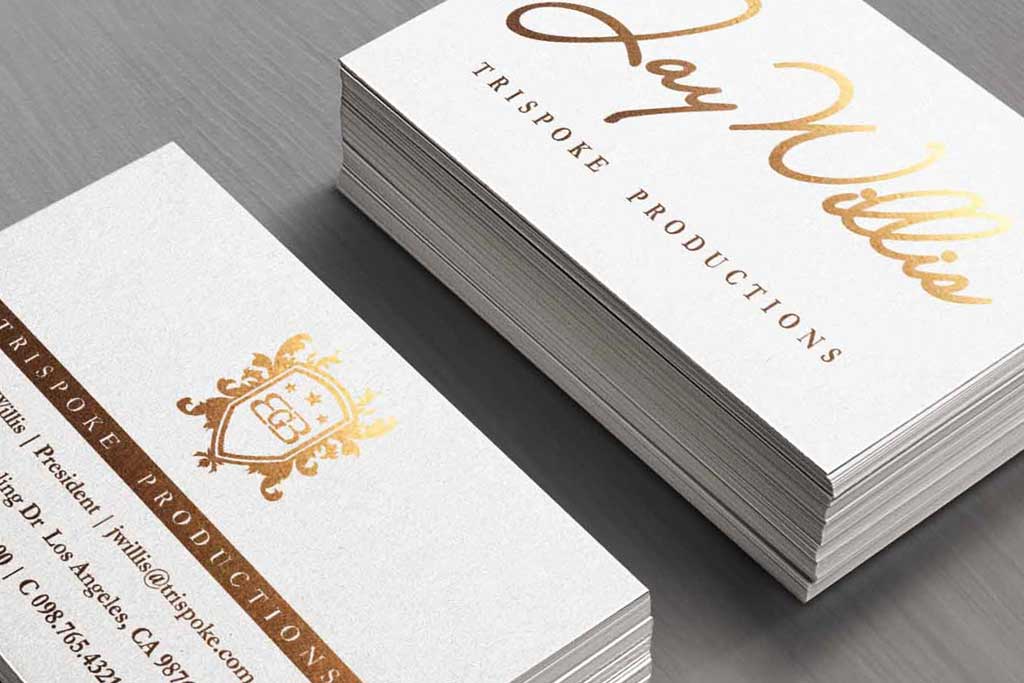Frequently Asked Questions
What is a foil embossed logo?
A foil embossed logo is a design technique that involves applying a metallic foil onto a surface and then pressing it with heat and pressure to create a raised, shiny, and eye-catching effect.
What is a foil stamp business card?
A foil stamp business card is a type of printed card that features a metallic or glossy design element applied using heat and pressure, creating an eye-catching and luxurious appearance.
What is embossed gloss finish business card?
An embossed gloss finish business card is a type of business card that features raised, glossy elements on its surface, adding a tactile and visually appealing effect to the design.
What should not be laminated?
Delicate or heat-sensitive materials such as photographs, thermal paper, and certain types of artwork should not be laminated.
How rare are foil cards?
Foil cards are considered relatively rare due to the specialized printing process and the added value they bring to collectible items.
Why are foil cards so expensive?
Foil cards are expensive due to the specialized printing process, high-quality materials, and the added value they bring to collectible items.
How can you tell if a card is foil?
Foil cards can be identified by their shiny metallic appearance, created through the application of a thin layer of foil onto the surface of the card.
Are foil cards worth anything?
Foil cards can hold significant value due to their unique visual appeal and limited availability, making them highly sought after by collectors and enthusiasts.
What is the difference between foil stamped and embossed?
Foil stamping involves applying a metallic or colored foil onto the surface of a material, while embossing creates a raised design by pressing the material from underneath.
How does foil stamping work?
Foil stamping is a printing technique that uses heat and pressure to transfer metallic or pigmented foil onto a surface, creating a shiny and eye-catching design.
What does foil stamping require?
Foil stamping requires the use of heat, pressure, and a metallic foil to create a decorative and eye-catching design on various materials.
What pens can write on laminate?
Gel pens with quick-drying ink are the most suitable for writing on laminate surfaces.
What is the difference between gloss and satin business cards?
Gloss business cards have a shiny, reflective finish, while satin business cards have a smooth, matte finish.
Who does hot foil stamping work?
Hot foil stamping works by using heat and pressure to transfer a metallic or pigmented foil onto a surface, creating a visually appealing and durable design.
What is the difference between hot stamp and foil stamp?
Hot stamping and foil stamping are both methods of applying metallic or colored foil onto a surface, but hot stamping uses heat and pressure to transfer the foil, while foil stamping uses a heated die to press the foil onto the surface.
What is the difference between laminated and non laminated business cards?
Laminated business cards have a protective layer that enhances durability and gives a glossy finish, while non-laminated business cards do not have this added layer.
What are the benefits of laminated cards?
Laminated cards offer enhanced durability, protection against wear and tear, and a professional appearance, making them ideal for long-lasting promotional materials.
What does it mean to laminate a card?
Laminating a card involves applying a protective layer of plastic film to enhance durability and prevent damage.
Should business cards be laminated?
Laminating business cards can enhance their durability, protect against wear and tear, and give them a professional and polished look.
Should you laminate business cards?
Laminating business cards can enhance their durability, protect against wear and tear, and give them a professional and polished look.
What is the difference between matte and silk business cards?
Matte business cards have a non-glossy finish, while silk business cards have a smooth and slightly glossy appearance.
What is silk card?
Silk card is a high-quality, smooth, and luxurious type of cardstock that adds a touch of elegance to printed materials.
What is the difference between silk and glossy cards?
Silk cards have a smooth, matte finish, while glossy cards have a shiny, reflective surface.
What is silk cardstock like?
Silk cardstock is a high-quality, smooth-textured paper that adds a luxurious and elegant touch to printed materials.
What does silk cardstock mean?
Silk cardstock refers to a high-quality, smooth-textured paper with a luxurious finish, commonly used for premium printing materials.
What is silk laminated business cards?
Silk laminated business cards are high-quality, durable cards that have a smooth and luxurious finish due to a thin layer of silk film applied to both sides.
What is the difference between silk and velvet lamination?
Silk lamination provides a smooth and glossy finish, while velvet lamination offers a soft and luxurious texture.
Is silk paper glossy or matte?
Silk paper has a smooth, semi-gloss finish that falls between glossy and matte.
What finish is better for business cards?
The best finish for business cards depends on the desired aesthetic and functionality, with options including matte, gloss, satin, and spot UV.
What is the best finish for business cards?
The best finish for business cards is a combination of matte and spot UV coating, which provides a sleek and sophisticated look while also enhancing durability.
What is the best lamination for business cards?
The best lamination for business cards is a high-quality, glossy finish that enhances the design and provides durability.
Which material is best for business cards?
The best material for business cards is a high-quality, thick cardstock that is durable and has a professional finish.
What is the best paper for homemade business cards?
The best paper for homemade business cards is a high-quality cardstock with a weight of at least 300gsm, providing durability and a professional look.
Do I want glossy or matte business cards?
The choice between glossy or matte business cards depends on the desired aesthetic and the impression you want to make on your target audience.
How much do foil business cards cost?
The cost of foil business cards can vary depending on factors such as quantity, design complexity, and additional finishes, but typically range from $100 to $500 for a standard order.
What are the different types of lamination business cards?
The different types of lamination for business cards include gloss, matte, soft touch, and spot UV.
What are the different types of lamination on business card?
The different types of lamination on business cards include gloss, matte, soft touch, and spot UV.
Are thicker business cards worth it?
Thicker business cards can create a more premium and memorable impression, making them worth the investment for businesses looking to stand out.
What is velvet laminated business cards?
Velvet laminated business cards are high-quality, luxurious cards that have a soft, velvety texture and a protective layer of lamination for added durability and elegance.
Will a QR code work through lamination?
Yes, a QR code can still be scanned through lamination as long as the lamination is not too thick or reflective.
Are foil cards legal?
Yes, foil cards are legal and widely used in various industries for their aesthetic appeal and added value.
Can you write on glossy business cards?
Yes, glossy business cards can be printed on to create a sleek and polished look.
Can Sharpie write on laminate?
Yes, Sharpie markers can write on laminate surfaces due to their permanent ink formula.
Is silk card glossy?
Yes, silk card has a smooth and semi-gloss finish that adds a touch of elegance to printed materials.
Can you write on silk card?
Yes, silk card is a premium printing material that offers a luxurious and smooth texture, making it an excellent choice for creating high-quality visual materials.
Can you write on silk laminated business cards?
Yes, silk laminated business cards are a popular and luxurious option for creating visually stunning and durable promotional materials.
Can you write on silk laminated paper?
Yes, silk laminated paper is a versatile and high-quality option for creating visually stunning printed materials.
Can you write on uncoated business cards?
Yes, uncoated business cards can be written on due to their porous surface that allows for easy pen or pencil markings.









MMs
05-29-23
United States
Verified Buyer
On the recommendation of a fried, I ordered 1000 business cards. Great customer service and follow up and a quality product. From a previous owner of a manufacturer business, these guys got it together.
Jonathon
04-10-23
United States
Verified Buyer
Proofs were turned around quickly and product was delivered as promised.
ChalkySouth
02-18-23
United States
Verified Buyer
Yassssssss! Cards were great. Very happy with these guys and local too – that’s handy.
MilliesOutlet
03-07-24
United States
Verified Buyer
Excellent service and excellent quality cards, would definitely recommend.